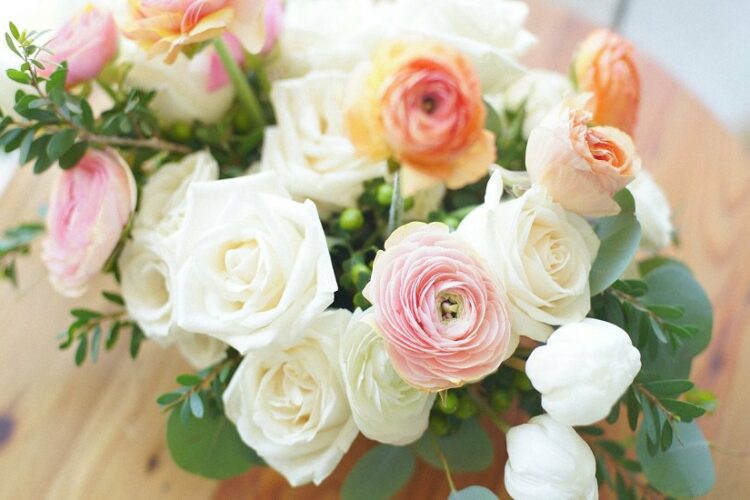How Is Harmony Used in Floral Design

Harmony, or how is harmony used in floral design is very important the colors, shapes and sizes of the flowers and leaves. Must work together to create an attractive arrangement that harmonizes with the theme of your event or business meeting. Wedding ceremony, or other special occasion you are celebrating with flowers.
A florist’s goal when designing an arrangement is to make it as beautiful as possible. Using interesting arrangements to complement the colors and style of your venue and the dress worn by the bride. To achieve harmony in your designs, keep these tips in mind when selecting your flowers.
The Concept of Harmony
Harmony and balance are at the heart of all successful floral designs. These two elements are often used interchangeably, but they’re not always the same thing. Balance means that the arrangement has equal weight on either side.
For instance, a bouquet with heavy flowers on one side and lighter flowers on the other would be balanced. The goal of balance is to create an even distribution of weight throughout the arrangement so it looks more natural.
Harmony, on the other hand, refers to a sense of peace or order that creates an emotional response from viewers. A well-executed flower arrangement will have both aspects: balance and harmony.
The Importance of Harmony
Harmony, or the art of balance and contrast, has been used for centuries to create some of the most beautiful pieces of art. In the world of floral design, it’s critical to understand how this concept can be translated into your arrangements.
The Wrap Around Extension Method is a technique that uses harmony as its primary driving force when arranging flowers together. The Wrap Around Extension Method Floral Design starts by selecting a central flower that will serve as the focal point for your arrangement.
Then you’ll select a flower color from each side (or adjacent) color wheel to create an arrangement. Which wraps around the central flower and creates an extended line of color.
What Color Styles Are You Seeking When Creating Harmonious Layouts?
What color styles are you looking for? Flowers are an excellent way to add color to your home and office space. The colors that you select for your arrangement will depend on what colors work best with the existing colors or materials in the room, as well as the occasion.
A wrap around extension method floral design adds a touch of elegance to any arrangement. Because it surrounds the bouquet with several layers of petals, foliage, and flowers. This type of arrangement can be perfect for weddings, showers, and other formal events.
To achieve this look using flowers like roses or tulips (or any other type). Start by placing one flower at a time inside a container or vase that has been filled with water.
Elements In Floral Design
Floral Design can be divided into three main categories: Nature Inspired, Traditional, and Contemporary. The first category includes creating designs based on the natural world around us. This includes real flowers, leaves, fruits, vegetables and other natural objects.
When designing with these elements it is important to remember that they are fragile and should be handled accordingly. In order to achieve a natural look in your design you would use the Wrap Around Extension Method Floral Design technique.
Which involves wrapping a flower around a stem as opposed to using wire or pins. Another way to achieve this effect is by using live plants or artificial plants with silk flowers.
Using Different Types of Vases with Flowers
If you are looking for a way to create balance and symmetry with your flowers, try the wrap around extension method. This technique uses multiple vases of different sizes as well as wrapping these vases together with an extension type floral design.
When done correctly, this technique creates a beautiful symmetry on either side of a room. To start, choose two vases of different sizes that will work well together. Next, use an extension method to wrap the small vase around the larger vase. So, that it looks like it’s sitting on top of the larger one.
The Principles of Floral Design
In order to create a stunning floral display, you need to know the basics Principles of Floral Design of how to arrange flowers.
There are five basic principles that every florist needs to master:
- balance
- contrast
- focal point
- repetition, and
- harmonious color scheme.
The first principle that applies to any arrangement is balance. This means arranging the flowers so they will not topple over when they’re displayed upright.
Try wrapping around extension method or branch out extension method for trees- this technique can hold heavy branches while also adding height to your display.
Contrasting colors create visual interest by drawing attention to one part of an arrangement while allowing other parts of it to recede into the background.
How To Choose the Right Floral Arrangement
Many people think that all floral arrangements are the same. But there are many different kinds of arrangements and each one has its own specific purpose.
Some arrangements are designed to bring cheer. While others are designed to commemorate a special event or honor a person’s life.
The most popular arrangement among florists today is the wrap around extension method. Which can be seen on HGTV’s hit show Designing Spaces with Vern Yip.
Beauty In Floral Designs
The beauty of flowers isn’t just in their colors and shapes, but also the way they are arranged. This arrangement is called harmony. This method of arranging flowers has been studied for centuries and can be applied to different types of arrangements.
Such as bouquets, table centrepieces, garlands, topiaries, and more. The wrap around extension method typically uses a variety of height levels with a mixed selection of colors within each level.
Tips For Creating a Harmonious Space
Creating a harmonious space can be as easy as using a few key concepts when incorporating your decor. One of the most popular methods for achieving balance and harmony in your home or office is to use what’s called the wrap around extension method.
Which focuses on creating a cohesive flow throughout the room by extending one element, like color or pattern, around the space. For example, if you want to create a cohesive feel with reds and oranges.
You could start by draping your bedding and curtains with these colors and then add pops of reds and oranges. Throughout the rest of the room such as flowers.
Another option would be to use similar colors but different patterns that complement one another rather than repeating patterns that look too similar.
Conclusion
The use of flowers can be a beautiful part of wedding decor. The color, shape, and number of flowers can all have meaning to one’s wedding. And may need to be considered during the planning process.
If you are looking for an additional resource for your flowers and how they may play into your decor plan, explore this online blog. Here you will find an excellent guide on how is harmony used in floral design wich includes tips for both florists and DIY brides-to-be.
From understanding what types of flowers would work best with different colors to helpful advice about price ranges and where to shop; this site has it all.
It even features tutorials for those who would like to learn more about wrap around extension method floral design techniques!
How Is Harmony Used in Floral DesignWrap Around Extension MethodWrap Around Extension Method Floral Design
